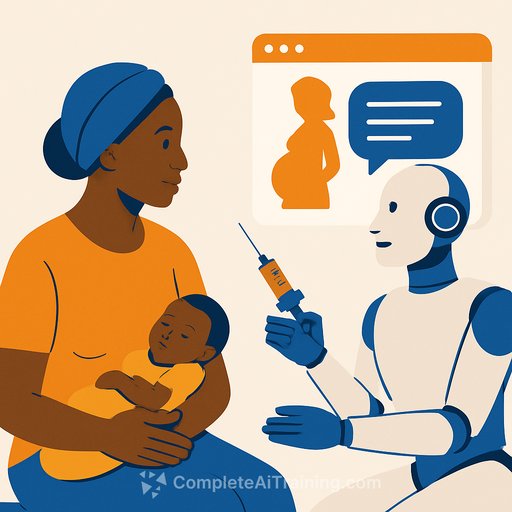Vaccines and motherhood: are AI-generated health messages working in Kenya and Nigeria?
Picture this: an AI system drafts a youth-focused post for Kenya, full of slang and the line "YOUNG, LIT, AND VAXXED!" It addresses fears about fertility and vaccines - a real barrier with real consequences. But the voice feels off. An algorithm trying to sound cool while talking about reproductive health can backfire.
That tension sits at the center of a recent analysis comparing 120 health campaign messages in Nigeria and Kenya - 80 from ministries and NGOs, 40 from AI tools. The focus: vaccine hesitancy and maternal healthcare. The headline result: neither approach won. AI was creative yet error-prone; traditional campaigns were authoritative yet rigid. The shared miss: genuine community empowerment.
What the comparison showed
AI-generated content included more cultural references than many human-made materials. It attempted local metaphors, farming analogies, and community-centered language. But those references often felt shallow or were inaccurate. Rural metaphors alienated urban audiences; some cultural nods landed as stereotypes.
Image outputs were another concern. AI sometimes produced distorted faces, especially for people of color, reflecting gaps in training data. Even purpose-built tools showed limits: the WHO's S.A.R.A.H assistant was reported to give incomplete answers and uses a default white female avatar - a design choice that raises representation questions. See: WHO S.A.R.A.H.
Traditional campaigns had their own issues. They leaned heavily on western medical framing, leaving little space for community knowledge or traditional practices. This mirrors a broader pattern, visible during COVID-19 debates over intellectual property and vaccine access, where local agency was sidelined.
Why this matters for your work
AI adoption in African health systems is accelerating. Early reports suggest deployments are clustering in telemedicine (~31.7%), sexual and reproductive health (~20%), and operations (~16.7%). Kenya has piloted AI consultation tools to reduce diagnostic errors, and Nigerian providers report gains in access with AI triage and messaging.
But speed without context repeats old mistakes. Vaccine confidence and maternal health decisions hinge on trust. If communities feel spoken at - rather than listened to - uptake stalls and risks rise.
A practical playbook for health teams
1) Co-design from day zero
- Run listening sessions with mothers, youth, CHWs, and traditional leaders before any content is drafted.
- Co-create message frames that reflect local priorities (e.g., fertility concerns, transport costs, clinic wait times).
- Prototype messages with small groups; keep what resonates, scrap what doesn't.
- Position people as decision-makers. Use prompts, questions, and options - not commands.
2) Train and tune AI with local data
- Feed models with locally sourced language examples (dialects, idioms, radio scripts, WhatsApp threads with consent and de-identification).
- Document data provenance; build a lightweight dataset registry and bias log.
- Add human-in-the-loop review for any clinical claims or dosage/time-sensitive guidance.
3) Fix representation and imagery
- Audit AI image outputs monthly for skin tone accuracy, facial symmetry, and context fit.
- Use diverse, locally produced photo libraries where AI outputs fall short.
- Avoid default avatars that reinforce external authority or exclude local identities.
4) Build a message architecture that respects context
- Segment by urban/rural, language, age, pregnancy stage, and caregiver role.
- Align channels to behavior: WhatsApp for peer Q&A and myth-busting, radio for reminders, Facebook for clinic updates, facility posters for steps and signals.
- Test tone variants: empathetic nurse voice vs. peer mentor vs. community leader.
- Keep copy short; lead with benefits, address one myth at a time, and end with a clear next step.
5) Guardrails for accuracy and safety
- Require clinical sign-off for any content tied to timing (vaccination schedules, danger signs in pregnancy).
- Cite or link to an official source for sensitive claims, or direct to a verified hotline or clinic.
- Set rules for AI to avoid speculation; instruct it to say "I don't know" and escalate when uncertain.
6) Metrics that matter (beyond clicks)
- Trust and empowerment: pre/post micro-surveys on "I feel confident making this decision."
- Behavioral outcomes: completed vaccinations, antenatal visits, postnatal checks.
- Equity: performance by language, location, and income segment - not just averages.
- Quality: AI error rate, retraction rate, and time-to-correction metrics.
- Speed: time from rumor detection to verified response.
7) Governance and procurement basics
- Insist on model cards, data-use statements, and audit logs from vendors.
- Follow national data protection rules; de-identify messages and feedback data.
- Define escalation paths for clinical questions and adverse event reports.
8) Capacity building that sticks
- Train comms teams on prompt testing, bias checks, and A/B experimentation.
- Enable CHWs to collect anonymized message feedback during routine visits.
- Fund local AI partners; they bring context you can't fake.
Rapid pilot blueprint (6 weeks)
- Week 1: Stakeholder mapping, listening sessions, baseline metrics.
- Week 2: Draft message variants (AI + human), clinical review.
- Week 3: Community testing; revise using feedback.
- Week 4: Launch in 2-3 channels; set up rumor monitoring.
- Week 5: Optimize based on engagement, comprehension, and trust signals.
- Week 6: Report outcomes, document learnings, plan scale-up or pivot.
The takeaway
AI won't fix trust by itself. Traditional authority won't either. What works is a loop: listen, co-design, test, verify, and improve - with communities at the center.
If you're building AI-assisted health messaging today, start small, measure what matters, and keep humans in control of clinical accuracy and cultural fit.
Resources
- WHO's health communication assistant: S.A.R.A.H
- Upskilling your team in prompt design and QA: Complete AI Training - courses by job
Your membership also unlocks:






